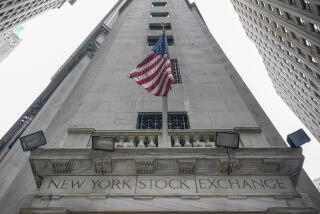Corporate Bankruptcies Soar to Record
- Share via
Showing the depth of the economic downturn, a record 224 public companies with a combined $180 billion in assets have gone to Bankruptcy Court this year, a research company reported Wednesday.
With six weeks left in the year, filings already have soared 27% over last year’s all-time high of 176 bankruptcies of public companies, according to BankruptcyData.com, a Boston company that tracks filings. Mega-bankruptcies involving assets of more than $1 billion have nearly doubled. The data are current through Tuesday.
With the economy sagging, corporate sales far behind last year and more companies teetering on the brink since the terrorist attacks, experts said bankruptcy petitions will increase into next year.
“We haven’t even begun to see all the fallout from Sept. 11,” said Glenn Siegel, a New York bankruptcy lawyer.
Siegel, who chairs the American Bankruptcy Institute’s public company committee, expects more firms in the travel industry to seek protection from creditors. Since the terrorist attacks, two cruise lines, a bus line, the Aladdin hotel-casino in Las Vegas, the parent company of Alamo and National car rental companies and a number of restaurant chains have sought protection from creditors.
Publicly traded companies make up a small part of overall business insolvencies. The institute reported that total business failures, though not on pace for a record year, grew 8.7% in the first six months to 20,335 petitions from 18,699 in the first half of last year.
After a decade of prosperity and a technology revolution that still is reshaping the nation, the economy and high-tech companies in particular were caught in an overly confident run-up in production, a meltdown of dot-com operations and a general weakening in demand for everything from clothes to electronic gadgets.
Publicly held corporations began turning to Wall Street to borrow money through debt securities.
“When there’s a lot of debt financing, you can expect that about two years later bankruptcies will increase,” said Lynn M. LoPucki, a UCLA law professor who specializes in bankruptcy issues. “There’s been a lot of debt financing in the past few years, and very recently, there has been an increase in debt financing. So you can expect the increase in bankruptcies to continue.”
What surprised LoPucki was that this year’s data include 38 corporations with more than $1 billion in assets each, among them Polaroid Corp., Trans World Airlines Inc. (since acquired by AMR Corp.) and Burlington Industries Inc., and about two dozen of those have filed since July 1. Last year, 21 such companies filed bankruptcy petitions.
But he figures that even that trend may continue. “Companies are bigger now than they were only a few years ago,” he said. “It used to be that companies that large usually didn’t file bankruptcy petitions. They were too big to fail and solved their financial problems through negotiations.”
That all began to change after 1987 when revisions in the Bankruptcy Code allowed companies to remain in control of operations while reorganizing their debts.
Among the bankruptcy victims this year are well-known names such as AMF Bowling, Converse sneakers, Schwinn bicycles, Vlasic pickles, Coleman camping gear and Sunbeam appliances.
Bethlehem Steel Corp. joined more than a dozen other steelmakers in Bankruptcy Court as low-priced imported steel made it difficult to compete.
In April, California’s largest utility, Pacific Gas & Electric, became the third-largest bankruptcy case ever behind Texaco Inc. in 1987 and Financial Corp. of America in 1988. PG&E; lost more than $9 billion paying more for power than it could bill customers under the state’s flawed deregulation scheme.
And the largest movie theater chains, including Regal Cinemas Inc. and Loews Cineplex Entertainment Corp., were mired in red ink after new multiplex theaters led to an oversupply of screens.
“We all forget, but we can’t have prosperity forever,” Siegel said.
*
Bloomberg News was used in compiling this report.
More to Read
Inside the business of entertainment
The Wide Shot brings you news, analysis and insights on everything from streaming wars to production — and what it all means for the future.
You may occasionally receive promotional content from the Los Angeles Times.










